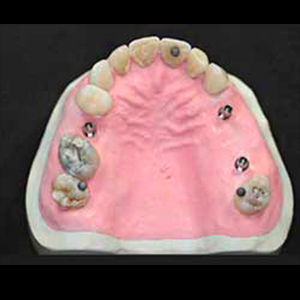Intraoral scanner accuracy: The influence of manual movement?

Published: 22 December 2021
Abstract Views: 1076
pdf: 774
Publisher's note
All claims expressed in this article are solely those of the authors and do not necessarily represent those of their affiliated organizations, or those of the publisher, the editors and the reviewers. Any product that may be evaluated in this article or claim that may be made by its manufacturer is not guaranteed or endorsed by the publisher.
All claims expressed in this article are solely those of the authors and do not necessarily represent those of their affiliated organizations, or those of the publisher, the editors and the reviewers. Any product that may be evaluated in this article or claim that may be made by its manufacturer is not guaranteed or endorsed by the publisher.
Similar Articles
- L. F. D'Arienzo, A. Casucci, M. Ferrari, R. Madeo, Accuracy, time efficiency and operator preference in edentulous arch scanning: a preliminary report , Journal of Osseointegration: Vol. 13 No. 3 (2021)
- G. Verniani, A. Casucci, N. Nosrati, L. F. D'Arienzo, M. Val, E. Ferrari Cagidiaco, Accuracy evaluation of two different intraoral scanners in implant prosthodontics. A comparative in vitro study , Journal of Osseointegration: Vol. 16 No. 1 (2024)
- G. Verniani, A. Casucci , E. Ferrero, C. Gaeta, E. Ferrari Cagidiaco, Accuracy evaluation of digital impressions on horizontal finish line designs , Journal of Osseointegration: Vol. 15 No. 4 (2023)
- R. Sorrentino, G. Ruggiero, R. Leone, M. Ferrari, F. Zarone, Area accuracy gradient and artificial markers: a three-dimensional analysis of the accuracy of IOS scans on the completely edentulous upper jaw , Journal of Osseointegration: Vol. 13 No. s4 (2021): Special Issue on Digital Dentistry - Supplement to 2021 Vol. 13 No. 4
- F. Ferrini, S. La Rocca, G. La Rocca, S. Speroni, N. Cantile, G. Gastaldi, Statistical evaluation of the learning curve in digital impression in different types of operators , Journal of Osseointegration: Vol. 17 No. 1 (2025)
- Federico Mandelli, Enrico Felice Gherlone, Andrew Keeling, Giorgio Gastaldi, Marco Ferrari, Full-arch intraoral scanning: comparison of two different strategies and their accuracy outcomes , Journal of Osseointegration: Vol. 10 No. 3 (2018)
- L. F. D'Arienzo, A. Casucci, P. Manneh, A. D'Arienzo, A. Borracchini, M. Ferrari, Digital workflow in complete dentures: a narrative review , Journal of Osseointegration: Vol. 12 No. 4 (2020)
- A. Biagioni, M. Pecciarini, M. Ferrari, A systematic review about randomized clinical trials on digital impressions on sound teeth , Journal of Osseointegration: Vol. 11 No. 1 (2019)
You may also start an advanced similarity search for this article.


 https://doi.org/10.23805/JO.2021.13.S04.5
https://doi.org/10.23805/JO.2021.13.S04.5








